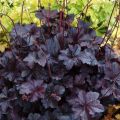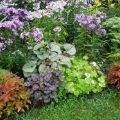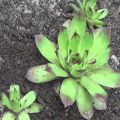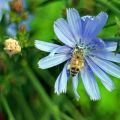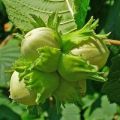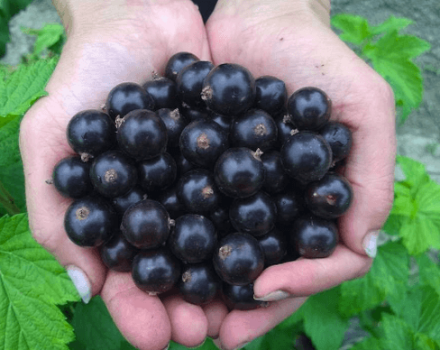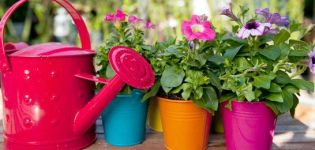Planting and caring for Heuchera in the open field, a description of the best varieties and reproduction
Ornamental plants are widely used in the arrangement of garden plots. One of the most remarkable flowers with unusual leaves is heuchera, planting and caring for which are simple and affordable for every summer resident. Compliance with the cultivation technology and the combination of various varieties allows you to get beautiful plants that together form a multi-color palette.
Description and characteristics of Heuchera
Geichera belongs to the perennial herbs of the Stonefragment family. The plant comes from the North American continent, prefers to grow along the banks of mountain rivers. However, modern horticulture has adapted the varieties for cultivation on plots in other areas. The height of the bush does not exceed half a meter, while the rosette is quite spreading and grows rapidly. Due to this property, the transplant of heuchera or its parts is used for plant propagation.
The appearance and characteristics of the flower are remarkable:
- dense leaves are located close to the root;
- petioles evenly long;
- the shade of greenery changes during growth;
- long peduncles exceed the height of the plant;
- small bell-shaped flowers are collected in dense panicles;
- fruits - seed pods;
- the seed is small, dull, in a dark brown palette.
Varieties and varieties of culture
Currently, there are no less than 70 types of Heuchera, each of which has a unique appearance. The high species diversity, the use of modern microchannel propagation of the plant made it possible to isolate the differences and develop a huge number of varieties of this flower.
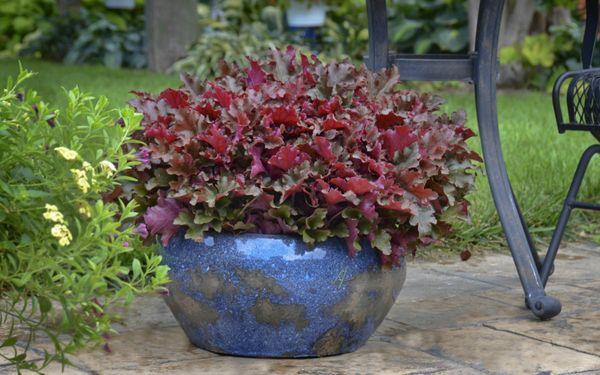
The following types are used in ornamental gardening:
- blood red;
- hairy;
- cylindrical;
- small-flowered;
- American;
- hybrid;
- gooseberry-leaved.
Heuchera blood red (Heuchera sanguinea)
This type of heuchera belongs to frost-resistant, shade-loving, unpretentious crops. This species is distinguished by an increased density of rounded leaves with a jagged edge. The plant blooms from the first half of June to the end of August, releasing long peduncles with panicles of small buds of bright red, raspberry or deep pink color.Sometimes small white and cream spots are present on the leaf blades. Popular varieties of the blood red look:
- Monet;
- Variegata.
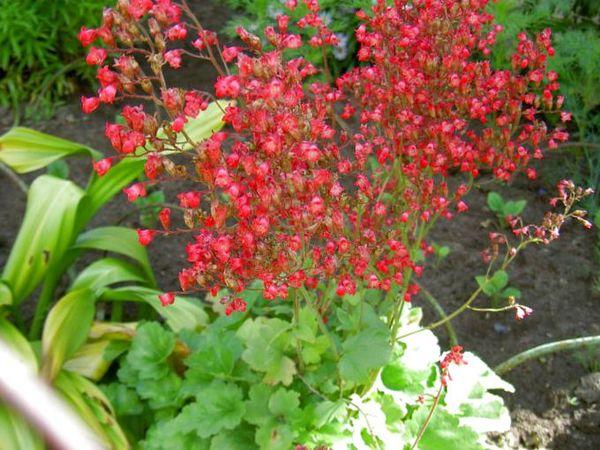
Heuchera hairy (Heuchera villosa)
The appearance significantly differs from others by the presence of a pubescent surface of leaves and villi on peduncles and petioles. Shades of leaves can be bronze-orange, light green and purple. Varieties with high decorative characteristics:
- Bronze Wave.
Heuchera cylindrica
The mountain variety grows well in full light or in low partial shade. The main feature is large cylindrical inflorescences on high peduncles. The palette of buds includes green, coral and red. The leaves are rounded, heart-shaped, with a green tint and contrasting lines and silvery-gray patterns. Common varieties:
- Green finch.

Heuchera micrantha
The attractive plant retains its decorative effect for a long time, keeping the foliage under the snow cover until the onset of spring. The bush is resistant to frost and drought, and is also easy to care for. The leaves are a bit like maple leaves, and can be purple or silvery green. The inflorescence consists of a large number of very small buds, pinkish cream in color with an orange center. Attractive small-flowered varieties:
- Palace Purple;
- Bresslngham Bronze.
American Heuchera (Heuchera americana)
The mountain flower is significantly lower than other species, the growth of the plant is not more than 0.2 m. The leaves stand out among others in a double color, they are green outside, and brownish-purple below. Yellow-green buds are located on long peduncles that are almost three times the height of the plant. The shade of the leaves changes during the growing season. The most popular variety among gardeners is Green Spice.
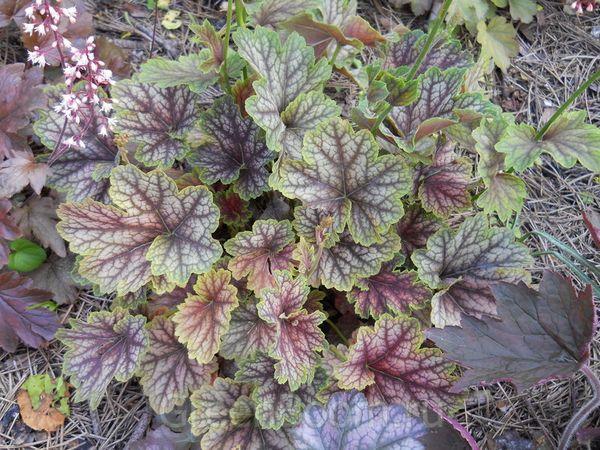
Heuchera hybrid (Heuchera hybrida)
Blood-red, American and small-flowered Heuchera participated in the appearance of this species. As a result, the plant has large flowers of white, pinkish, coral-red tones. The flowering period is 60 days or longer. The leaves are initially green with a contrasting pattern and creamy spots. It is necessary to plant this species in places protected from gusts of wind and intense rain. Common varieties of hybrid:
- Cappuccino;
- Beauty Color;
- Ruby Veil;
- Can Can.
Gooseberry Heuchera (Heuchera grossulariifolia)
The main advantage of this type of heuchera is not a patterned leaf, but exceptional resistance to frost and cold. The plant is able to survive even the most severe winter, completely preserving the aboveground part.
The subtleties of growing a plant
The cultivation of decorative heuchera has no special requirements, but there are a number of nuances that will help to get the maximum aesthetic pleasure from the plant:
- Peduncles of decorative deciduous varieties are removed immediately after their appearance, and in flowering varieties - before the formation of fruits.
- Young, fragile leaves must be protected from physical damage.
- Periodically, the flower needs to be transplanted into a hole deeper to prevent the appearance of friability of the bush.
- You can plant a culture in conjunction with decorative cereals, primroses, incense and daylilies.
Landing time and place
The right time to plant Heuchera is spring, starting in the second half of March. You can plant bushes in April if the ground is not warmed up enough. As for growing from seeds, you should be guided by the information on planting dates from the manufacturer. In the fall, the plant is not transplanted, but you can prepare cuttings and leave them indoors for the winter.

Most Heuchera varieties prefer partial shade, but there are some that become more attractive in direct sunlight. It is preferable to plant plants on the east or west side of the site.
Plant soil
The morphological composition of the soil is not an essential criterion, but, like most grasses, Heuchera prefers loose, fertile soil. The plant does not tolerate acidic soil well, acidity is allowed in the range of 5-6 pH, which corresponds to neutral indicators.
Acidified soil can be corrected by adding wood ash, dolomite flour, or chalk.
Heuchera grows best in conditions of good air permeability so that oxygen can easily pass through the soil. It needs a lot of moisture, which does not stagnate at the roots, therefore it is necessary to provide a drainage device. Expanded clay, clay chips and small pebbles are well suited for this.
Preparation of planting material
Heuchera can be grown from seeds or seedlings, the preparation of planting material depends on this:
- The rhizome of the seedlings obtained by dividing the bush is washed, and the cuttings are sprinkled with ash and treated with a preparation for root growth.
- The seedlings purchased in the store are examined in search of damage or signs of illness, they must be planted immediately after purchase.
- Before planting, the seeds are soaked for 2-3 hours in water for several hours, then they are allowed to dry out, and before sowing, mixed with river sand. Usually, cultivation of heuchera from seeds of their own collection is not practiced at home.
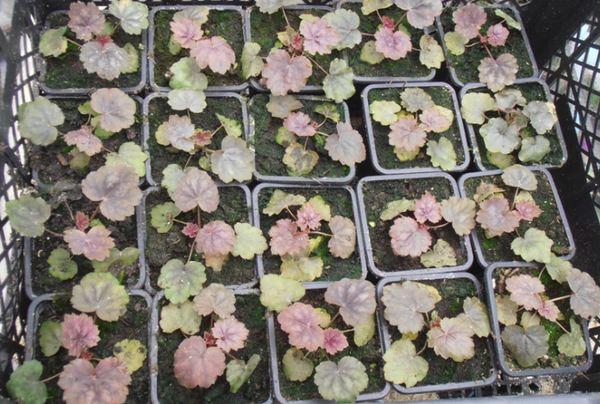
Planting process
The technology of planting Heuchera in open ground is simple and includes several stages:
- Preparation of planting holes with a diameter of 0.3 m and a depth of the same size.
- The distance between the bushes should be about 30 cm.
- The seedlings are lowered into the pit by transferring them from a container.
- The hole is filled with earth, lightly tamped.
- Each plant is watered abundantly at the root.
- Mulch the soil around the geychera with crushed peat, hay or sawdust.
Heychera care tips
After planting, the plants must be properly cared for:
- the soil should not dry out; for this, the irrigation regime is strictly observed;
- the earth is constantly loosened and freed from weeds;
- fertilizers are applied only to the type;
- heat-loving varieties are prepared for wintering in the fall.
Top dressing
During planting and the first year after, the flower does not need to be additionally fed. Starting from the second year in the open field, fertilizers are applied 2 times during the growing season, dividing the dose recommended by the manufacturer in half.
For those varieties of Heuchera, where the leaves are the decorative part, a complex of mineral fertilizers for deciduous crops is used. Varieties with a focus on the beauty of inflorescences are fed with universal mixtures for flowering plants.
 Watering
Watering
For high-quality growth and flowering, heuchera needs a well-moistened soil. However, the plant does not tolerate stagnant water at the roots, so the soil must be well drained. Watering is carried out regularly, at the first appearance of signs of drying out, usually 1 time per day. Hot dry summers can provoke strong evaporation of moisture, in this case, humidification is carried out twice. Water the flowers strictly at the root, avoiding contact with the leaves.
Preparing for winter
After the end of the growing season, heuchera is prepared for future cold weather. Most varieties tolerate winter well and without additional action from the gardener. However, to guarantee it is better to prepare a worthwhile protection. Oak leaves are well suited for hiding. In the spring they are harvested, and last year's leaves are cut at the roots.
An important condition for the wintering of Heuchera is the preservation of the aboveground part of the plant. Dry leaves help protect the root system from freezing.
Diseases and pests
Heuchera has good immunity, especially if the plants were obtained by microclonal propagation from healthy specimens and passed the necessary culling steps. However, adverse weather conditions and poor-quality agricultural technology can cause the following problems:
- Weak roots serve as food for the larvae of the weevil beetle.
- High humidity stimulates the reproduction of snails and slugs, which damage the leaves of the flower.
- Heuchera weeds can become infected with powdery mildew, rust or leaf spots. For treatment, fungicides and Bordeaux liquid are used.

Breeding methods
There are several ways to breed Heuchera:
- dividing the bush;
- cuttings;
- clonal micropropagation;
- seeds;
- sheet.
The simplest and most common are division and cuttings.
By dividing the bush
The procedure for dividing a plant to obtain seedlings has the following sequence:
- Heuchera is dug up.
- Shake and wash the roots.
- Divide the plant into 2-3 parts.
- Cut off dry or damaged leaves.
- Remove rotten roots.
- Containers for seedlings are equipped with drainage.
- Delenki are planted in a substrate for seedlings.
- Water the plants at the root.
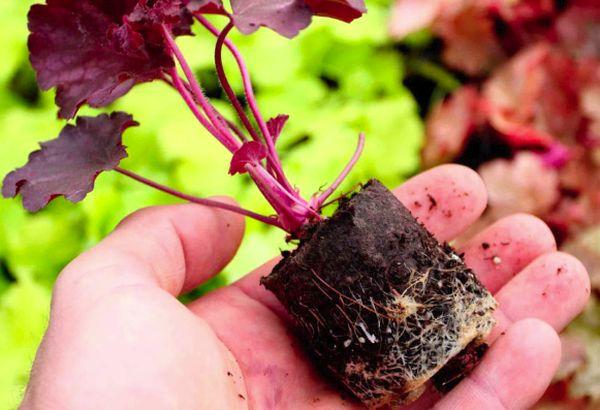
Cuttings
Pre-planting cuttings of Heuchera are carried out in this way:
- The rosette is cut from the plant along with part of the rhizome.
- Remove dry and rotten parts.
- Sections are treated with wood ash.
- Containers for seedlings are equipped with drainage and fill the soil.
- Shallow holes are made in the ground.
- The cuttings are lowered into the ground so that the rosette remains above the ground.
- Water the seedlings at the root.
Landscape design
Different varieties are often used in landscape design, as they retain an attractive appearance for a long time and are perennial. The bush is characterized by good compactness and tolerance to other crops. The flower is great for filling a space, masking or highlighting another plant. Geichera decorates domestic ponds and fountains, is used in the design of alpine slides, rock gardens and road curbs.
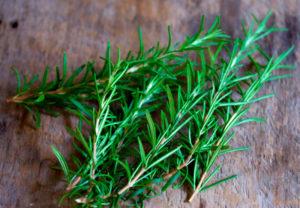
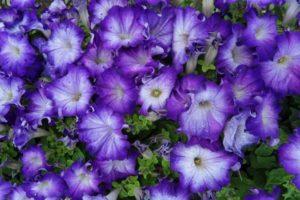
 Watering
Watering